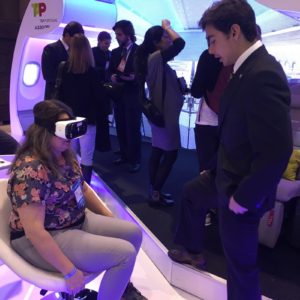
I am a serial Web Summit (WS) attendee. I first visited the WS in November 2014 in Dublin where I recorded a piece to camera about EdTech trends for 2015 – back then it was all about gamification and making learning a fun, enjoyable & most importantly – a user friendly experience for the student.
A lot has changed in 2 short years – education through distance learning (be it delivered online or by correspondence) is booming. The core attraction for many learners is the flexibility that it brings – you can literally study at any time, any place and any where. The 3 EdTech trends for 2017 bring this premise even further – beyond reality!
3 EdTech Trends for 2017
- Virtual Reality
- Augmented Reality
- Artificial Intelligence
1. Virtual Reality (VR)
VR is the computer-generated simulation of a three-dimensional image or environment that can be interacted with in a seemingly real or physical way by a person using special electronic equipment, such as a helmet with a screen inside or gloves fitted with sensors.
Educators can use a simulated environment to teach specific skills such as language skills and also practical science skills i.e. medical procedures. Imagine re-creating a street in Barcelona and being able to enter that environment as an avatar (both teacher & student) to walk around and converse in Spanish. What an amazing and immersive experience for both learner and teacher!

I spoke to Ebbe Altberg CEO of Linden Lab and creator of Second Life who was showcasing Sansar, a new tech for creating social experiences. He confirmed that there are many applications for VR in the education sector: “We want to lower the barrier of entry for VR experience creation,” said Ebbe Altberg, CEO of Linden Lab. “Project Sansar will do for virtual experiences what WordPress has done for the Web: empower a broad range of people to create with professional quality and reach global audiences. By greatly expanding who can create virtual experiences, Project Sansar will also extend the value of VR to a wide variety of use-cases — from gaming and entertainment to education, architecture, art, community-building, business meetings, healthcare, conferences, training, and more.”
2. Augmented Reality (AR)
AR is a technology that superimposes a computer-generated image on a user’s view of the real world, thus providing a composite view.
This technology can be used by educators to enhance the learning experience. A good example of successful application in learning in 2012 was the Harry Potter “Wonderbook: Book of Spells”, which encouraged children in their literacy skills. I met the creator of this phenomena Dr. Dave Ranyard who was studio head of Sony London until February 2016 & is now pursuing his own career in VR with his company “Dream Reality Interactive”. Today reality can be augmented by smartphones – bringing the still image to life & “Pokemon Go” has really helped to raise awareness of AR in recent times.
3. Artificial Intelligence
AI is the theory and development of computer systems able to perform tasks normally requiring human intelligence, such as visual perception, speech recognition, decision-making, and translation between languages.
I talked with Dutch AI start-up Illuminoo These guys create reflective intelligent agents that learn to know you personally and help you to improve in sports, work, health & education. This technology could be used to create a personalised learning experience – identifying where and when a learner may begin to struggle with a concept or procedure – before the student (or teacher) even realise it themselves!
Octopus v Oculus

My trip to Lisbon wasn’t all work – it was also a great social networking experience for both distance learning innovators and users. I even got to sample a local delicacy on my last day – grilled octopus. Would I go back next year? Definitely – but I’ll pass on the octopus next time!